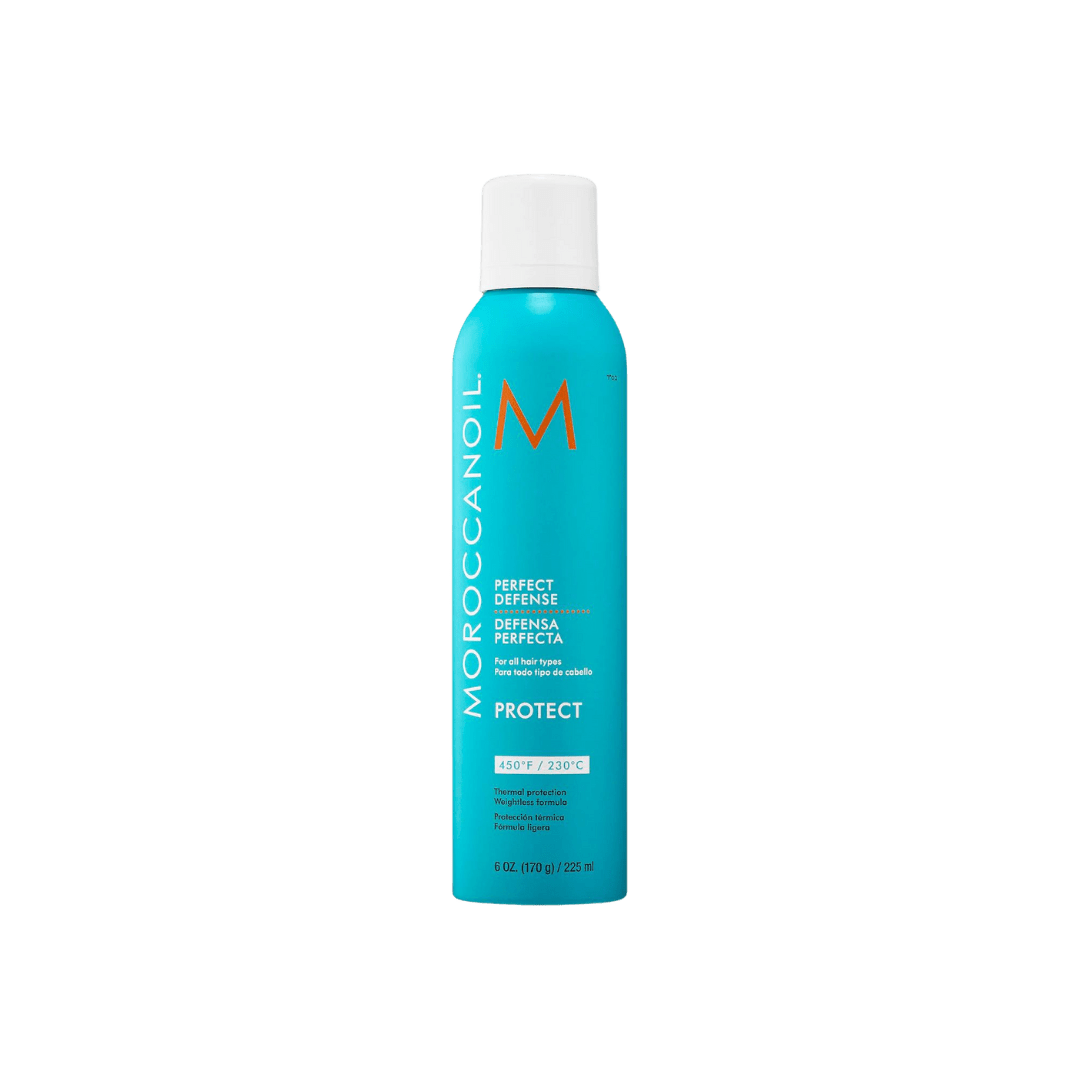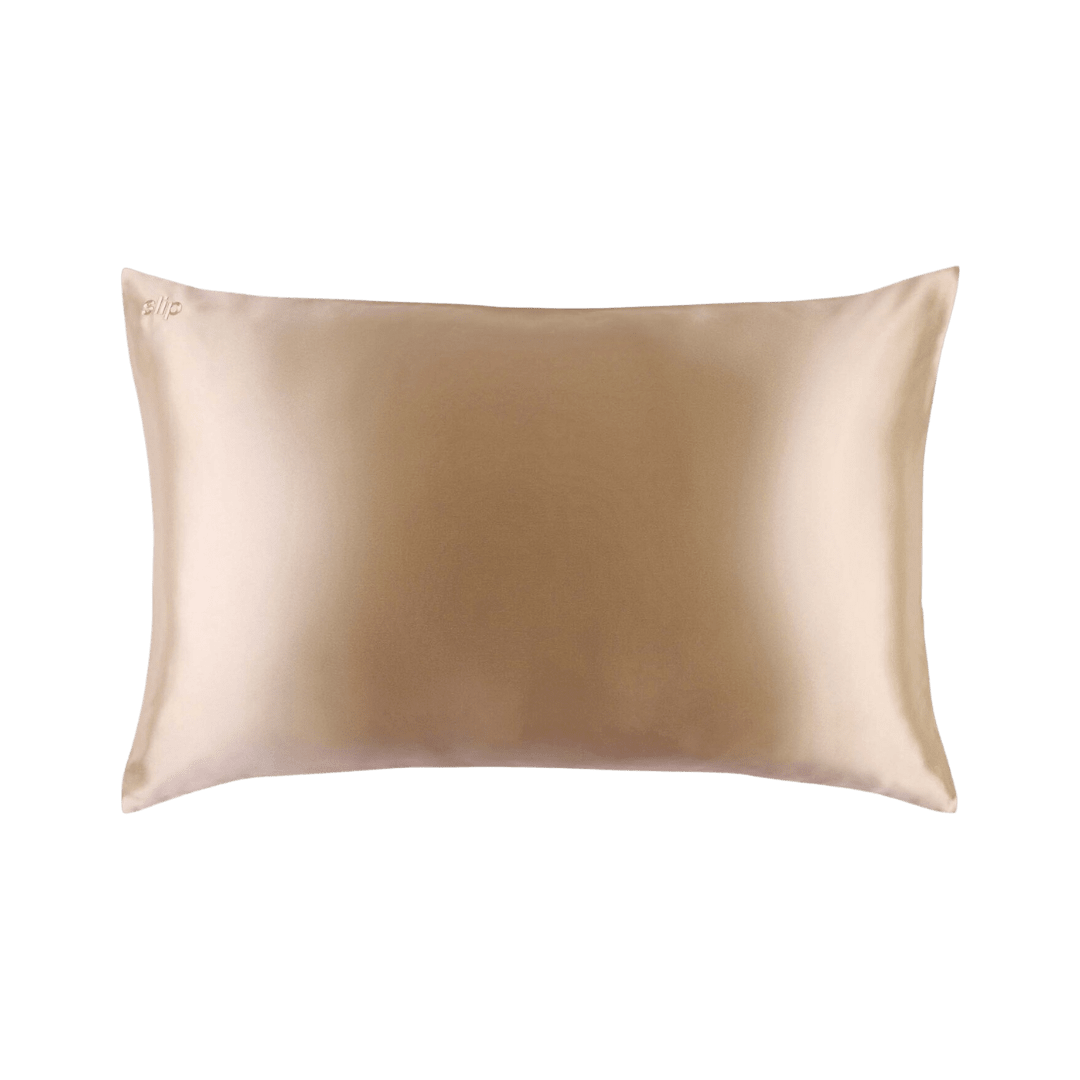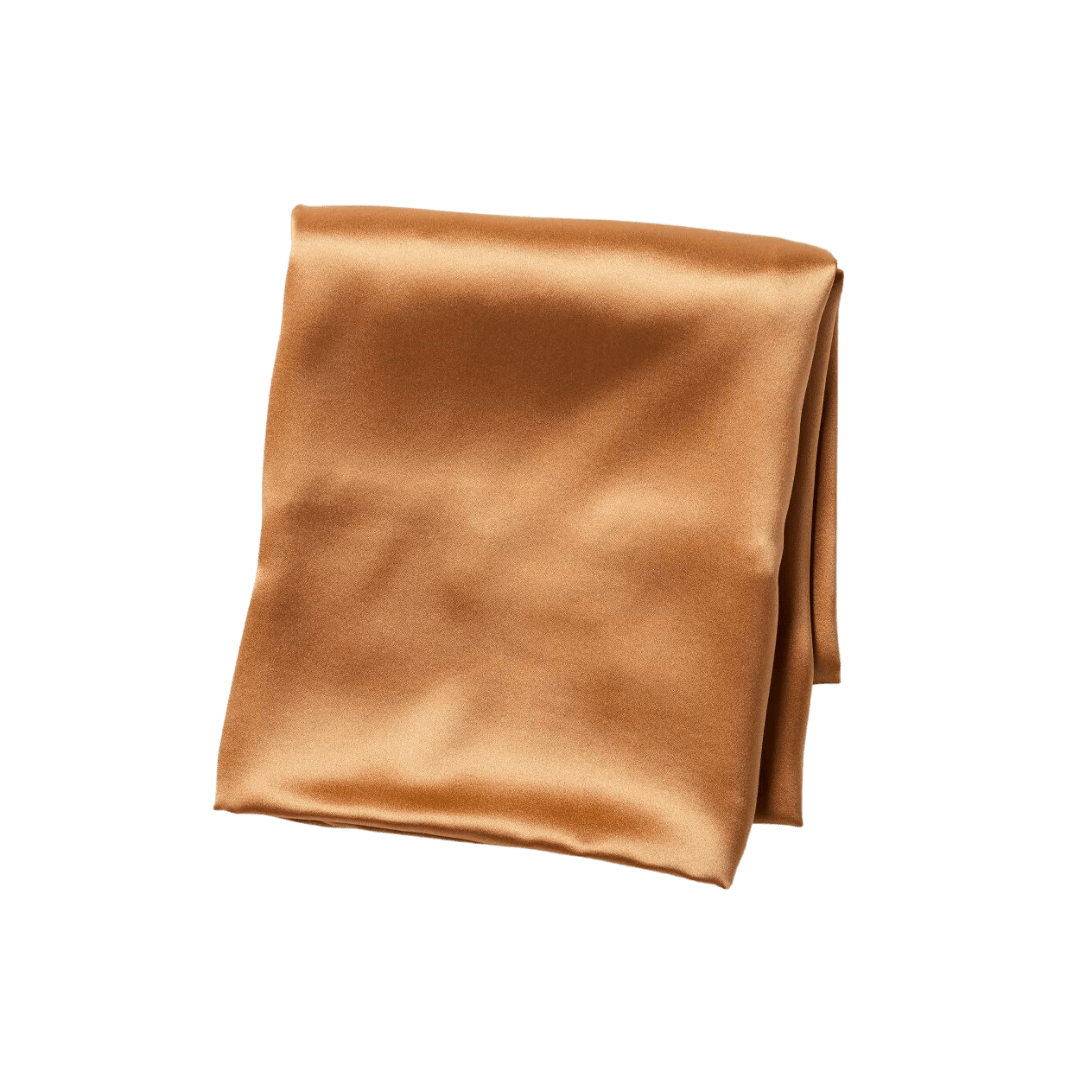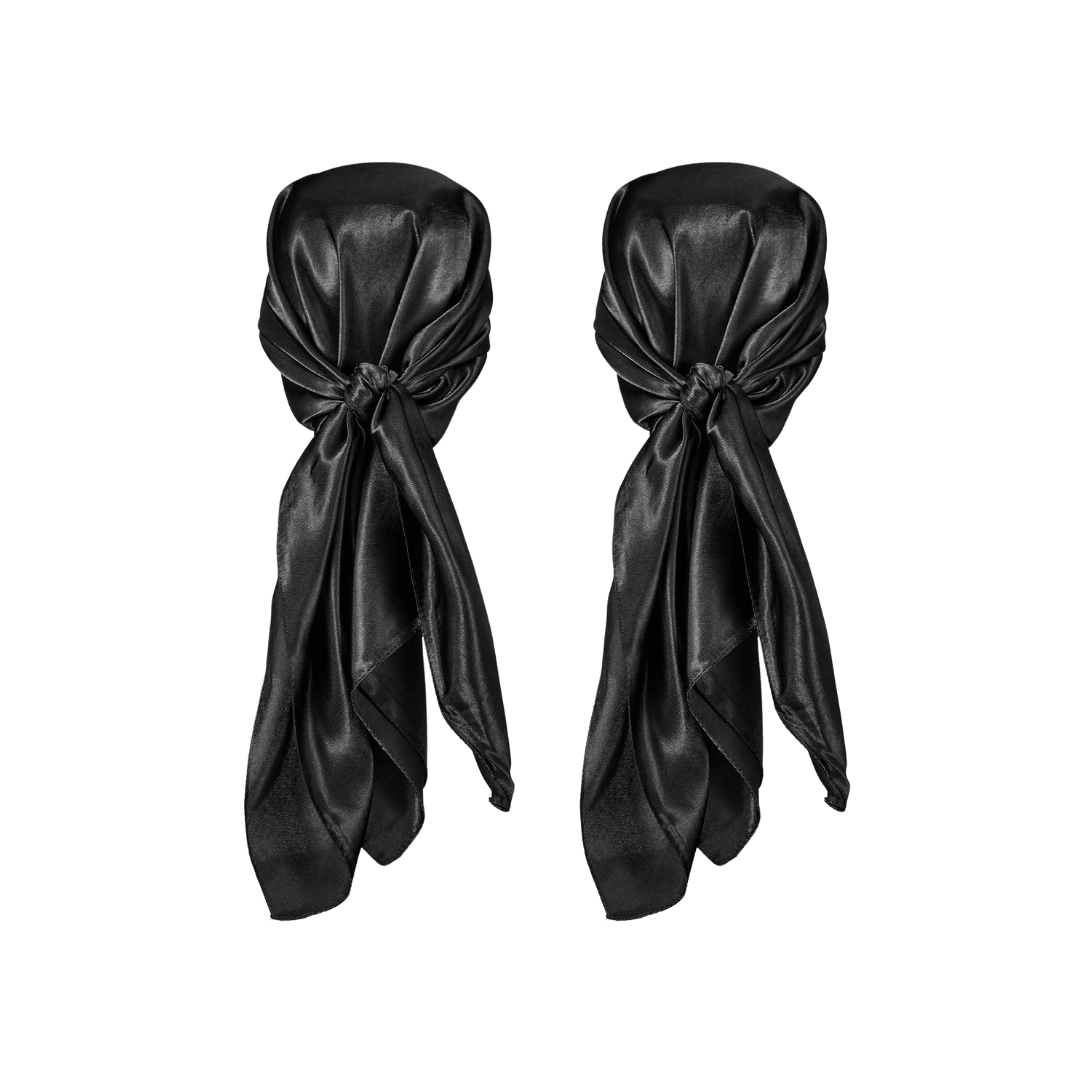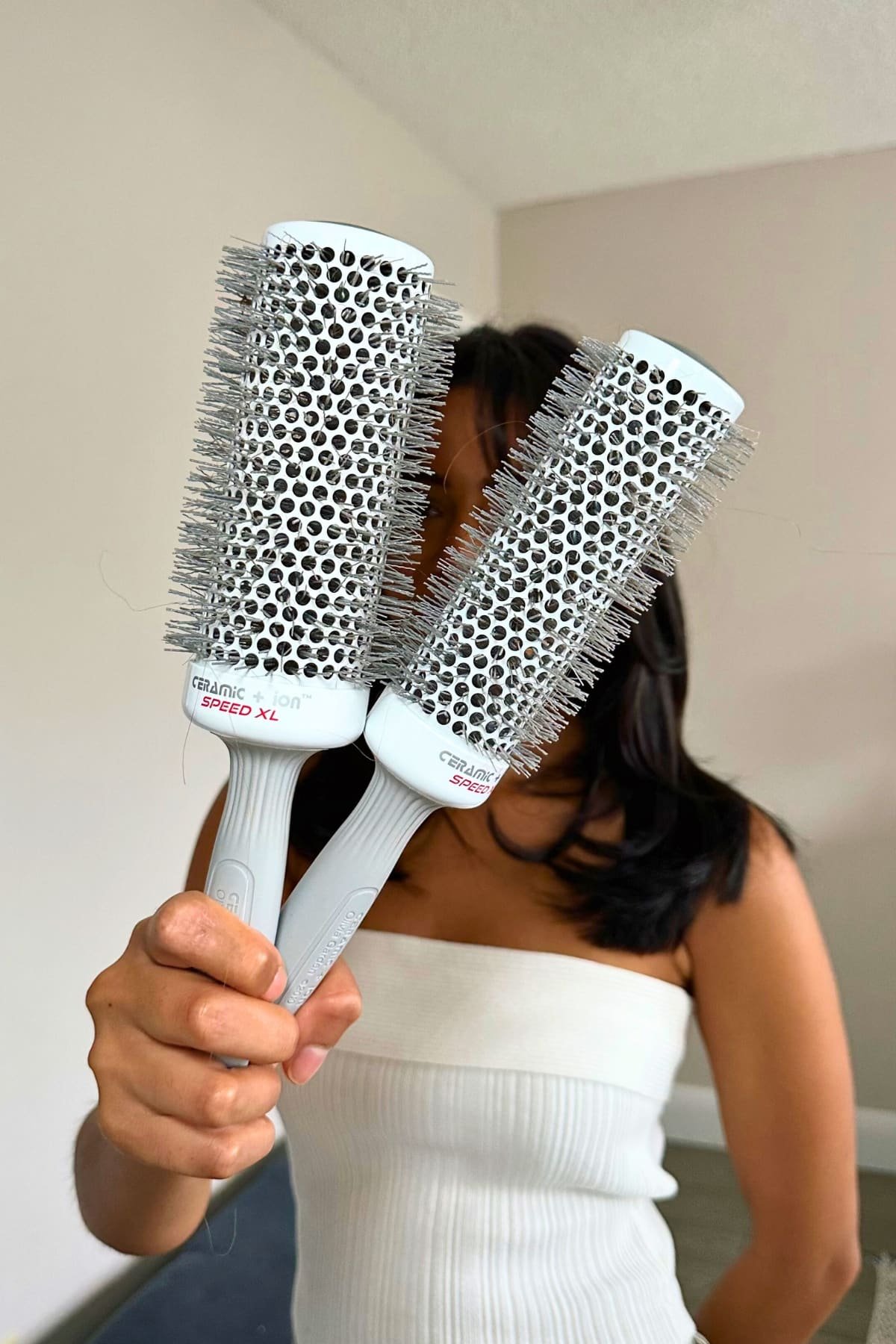Blowout Vs Silk Press: What's the Difference and What's Right for You?
This post may contain affiliate links, which means I'll receive a commission if you purchase through the link at no extra cost to you. Please read the full disclosure here.
Deciding between a blowout and a silk press for your upcoming hair styling appointment? You're definitely not alone in this hair riddle. As someone who's been styling hair for years, I totally get the confusion. These two styles might aim for the same goal – to make your hair look fabulous – but they're like cousins in the hairstyling family, similar but with their own unique flair.
In this guide, I'm going to break down the blowout vs silk press debate for you. We'll dive into what really sets these two apart, from the tools and techniques to how they work their magic on different hair types.
And trust me, by the time we're done, you’ll have a crystal-clear idea about which one to pick for your hair's needs and your style vibes. So, let's get started and uncover the difference between blowout and silk press, hairstylist style!
What is a Blowout?
A blowout is a hair styling technique designed to create a smooth, voluminous, and professionally styled look. This method involves more than just drying; it artfully combines a blow dryer with various brushes to shape and style the hair into your desired look. Whether you're aiming for straight, curly or subtly wavy hair, a blowout achieves this without the need for curling or flat irons. The end result is hair that's full of life and movement, adaptable to various hair types and lengths, and perfect for any style you desire.
The Process of Getting a Blowout
Getting a blowout is a pampering and transformative experience. Here’s what you can typically expect during a blowout session:
Washing: The process begins with a thorough wash using shampoo and conditioner. This step cleanses your hair and preps it for styling.
Applying Products: After washing, your stylist will apply various hair products. Depending on your hair type and desired style, these might include heat protectants, volumizers, or smoothing serums.
Sectioning Hair: Your hair is then divided into manageable sections. Sectioning is crucial for ensuring that each part of your hair gets equal attention during blow-drying.
Blow-Drying Technique: Using a blow dryer and round brushes, the stylist will dry each section of hair. The brush is used to pull your hair tight while the dryer applies heat, helping to shape and smooth your hair. The stylist might use different sizes of brushes to achieve the desired level of volume and shape.
Final Touches: Once your hair is dry and styled, the stylist may use additional products for hold, shine, or texture.
The blowout is complete, granting you polished waves and enviable volume that lasts for days.
FREE DOWNLOAD
THE ULTIMATE AT-HOME BLOWOUT STARTER KIT
Struggling to find find the right blow dryer, round brush, and hair products to give you that frizzy-free blowout? Don’t worry. This FREE starter kit has all my professional hairstylist hair tools and product recommendations!
Blowout Pros And Cons
Pros:
Versatility in Styling: Whether you’re looking for sleek straight hair, gentle waves, or bouncy curls, a blowout can be tailored to match your desired style.
Added Volume: A blowout can give your hair a significant lift and body, making it appear fuller and more vibrant.
Polished Look: There's a sleekness to the strands that whispers sophistication — it's a neat, finished style that's hard to replicate at home.
Suitable for Various Occasions: Perfect for special events, professional settings, or just a confidence boost, a blowout can elevate your look for any occasion.
Cons:
Potential Heat Damage: Frequent blowouts involve regular heat application, which can lead to hair damage over time if not properly managed.
Brittleness: Overdoing it is a no-go; too many blowouts without using heat protection can fray your hair, leading to breakage.
Limited Longevity in Humid Conditions: While a blowout can last several days, its lifespan can be shortened by humidity, which may cause the hair to frizz or lose its shape.
Time-Consuming: Unlike quick home styling, a professional blowout requires a salon visit and can take a significant amount of time, especially for longer or thicker hair.
Blowouts can be a great way to style your hair for different events. However, it's important to consider the potential downsides before making a decision. Exposure to heat regularly and the amount of time required are important factors to consider. Ultimately, whether or not a blowout is suitable for you will depend on your hair type, lifestyle needs, and how you balance your desire for style with the health of your hair.
What is a Silk Press?
A silk press is a hair straightening method that offers a chemical-free way to transform curly or coily hair into a sleek, smooth, and silky style. The process begins with a thorough shampoo, followed by a blowout to prep the hair. It then involves using a flat iron to 'press' the hair, creating that signature smooth and silky finish. This technique is especially favored for its ability to produce naturally straight-looking hair without the need for harsh chemicals, making it a gentler option for achieving a sleek hairstyle.
The Process of Getting a Silk Press
Getting a silk press involves a series of steps that ensure a smooth and lasting finish:
Hair Preparation: The journey to a silk press begins with a thorough wash using hydrating or clarifying shampoos to remove any buildup and to moisturize the hair.
Deep Conditioning: Following the wash, a deep conditioning treatment is often applied. This step is crucial for infusing moisture into the hair, a key element for a successful silk press.
Blow-Drying: Post conditioning, the hair is gently blow-dried. This is usually done using a comb attachment or a round brush to start straightening and remove tangles.
Heat Protection Application: Prior to flat ironing, a heat protectant is applied. This product is essential to shield the hair from potential heat damage during the silk press.
Straightening: The hair is sectioned and a flat iron is used to straighten each section. The iron's temperature is carefully adjusted according to the hair's thickness and texture to ensure smoothness without damage.
Finishing Touches: Finally, a light serum or oil may be applied to add shine and eliminate frizz.
Silk Press Pros And Cons
Pros:
Natural Appearance: One of the biggest advantages of a silk press is the natural-looking results. It straightens hair without altering its texture permanently.
No Chemicals: Unlike other straightening methods, a silk press doesn’t involve harsh chemicals, making it a safer option for hair health.
Versatility: It allows for a temporary change in hairstyle without a long-term commitment, perfect for those who like to switch between straight and curly styles.
Cons:
Heat Damage Risk: Although chemical-free, the silk press method involves the application of high heat, which can damage hair if not done correctly or too frequently.
Maintenance: Silk press styles require maintenance to keep the hair looking sleek, especially in humid conditions where hair may revert to its natural texture.
Cost and Time: A silk press can be a time-consuming process, often requiring a professional stylist's expertise, which might also make it a costlier option compared to regular styling.
While the silk press offers a stunning transformation with its smooth and silky finish, it's important to balance these aesthetic benefits with considerations of heat exposure and maintenance requirements. Whether a silk press is the right choice for you ultimately depends on your hair type, personal style preferences, and commitment to hair care post-treatment.
Difference Between Blowout And Silk Press
When it comes to hairstyling, the terms 'blowout' and 'silk press' often come up, but they aren't the same. Understanding the difference between silk pressing and blowout is crucial for those looking to choose the right style for their hair. While both aim for smooth and styled results, the techniques, tools, and outcomes vary significantly. Let's explore these differences to see which might suit your hair needs best.
Tools And Products Used
The blowout process typically utilizes a high-power blow dryer combined with various round brushes to achieve the desired style. The choice of brush size can affect the amount of volume and curl. Products used include volumizing mousses, heat protectants to shield hair from damage, and finishing sprays or serums to add shine and hold the style.
A silk press, on the other hand, primarily uses a flat iron for straightening. The process starts with a blow dryer for initial drying, followed by the flat iron for the sleek finish. Key products include heat protectants, which are essential to prevent heat damage, smoothing serums or creams for sleekness, and lightweight oils to enhance the silk-like finish.
Best Hair Types For Each Treatment
Blowouts work well on a variety of hair types but are particularly effective on fine to medium hair textures as they add volume and body. They can also smooth out slight waves and curls for a sleeker look.
The silk press is ideal for those with curly, coily, or thick hair. It straightens these hair types effectively without the need for chemical treatments, offering a safe alternative for those who frequently change hairstyles.
Texture And Appearance Post-Treatment
The result of a blowout is typically voluminous and can range from smooth and straight to bouncy with soft waves, depending on the technique used. The blowout is known for adding body and movement to the hair, making it a popular choice for a fresh and dynamic look.
In contrast, a silk press gives a very sleek, straight appearance. It’s particularly effective on curly or coily hair types, as it smooths out natural textures into a silky, straight form without using chemical relaxers. The finish is typically glossier and smoother than that of a blowout.
Styling Flexibility
With blowouts, you have the flexibility to explore various styles. From achieving a sleek, straight look perfect for formal settings to creating soft waves for a more casual, elegant appearance, the options are vast. Blowouts also allow for playful, bouncy curls, ideal for social events, and volumized layers that add depth to your hair. For a versatile and adaptable style, the half-up, half-down look works seamlessly with the volume and movement that blowouts provide.
On the other hand, silk presses, predominantly known for their classic straight style, offer a sophisticated and chic look. They are also excellent for sleek ponytails and updos, highlighting the smooth texture of the hair. For those with long layers, a silk press can enhance the straightness and add a touch of glamour. Even side-swept curtain bangs benefit from the silk press’s smooth finish. Post-treatment, you can introduce subtle curls or waves to add diversity to your style, though the range is slightly more limited compared to blowouts.
This styling flexibility means both treatments can cater to a variety of occasions and personal preferences, from the most formal events to everyday looks.
How Long Each Treatment Lasts
A blowout can last anywhere from 3 to 5 days, sometimes even a week, depending on how well it’s maintained, the hair type, and environmental factors. Using dry shampoos and avoiding moisture can extend its lifespan.
Silk presses can last up to two weeks with the right care. They require avoiding moisture and might need touch-ups with a flat iron for sustained sleekness. Wrapping hair at night and using silk or satin pillowcases help maintain the style longer.
Weather Impact
Blowouts might struggle in high humidity, leading to frizz or loss of shape. Silk Presses are more resilient but can still revert to the natural hair texture under extreme humidity. Proper product usage can mitigate these effects to an extent.
Seasonally, blowouts might be more manageable in drier seasons like fall or winter, whereas silk presses can be a great option year-round, given their higher resilience to humidity. However, additional care and the right products are key to maintaining both styles effectively during summer or in tropical climates.
Cost Considerations
When considering either a blowout or silk press, it's important to factor in the cost, which can vary significantly:
Blowouts: The price for a professional blowout in the U.S. and Canada typically ranges from $25 to $90. Prices might be higher in upscale salons or metropolitan areas like New York City or Toronto, where the demand and cost of living are higher.
Silk Press: Silk presses generally cost more due to the detailed process and skill required. Prices can range from $60 to $120 or more. Again, this varies with the location and salon. The price could go higher in some high-end salons or for particularly long or thick hair.
Remember, these are average figures and can vary. It's always best to check with local salons for the most accurate and current pricing. These costs reflect the expertise, time, and product quality that go into these treatments, contributing to their overall effectiveness and longevity.
Trend And Popularity
Both styles have their own dedicated following. Blowouts have long been popular for their versatility and ease, suitable for a range of occasions. Silk presses have recently seen a surge in popularity, particularly within the natural hair community, for their ability to straighten hair without chemicals.
Salon vs. At-Home
Mastering a professional blowout at home can be achievable with the right techniques and tools. While salon visits offer lasting and polished results, they can also be more expensive compared to the art of an at-home blowout. Recognizing this gap, I created 'Blowout Basics', a comprehensive course designed to empower you with the skills to achieve that bouncy, salon-quality blowout right in your own home.
'Blowout Basics' is more than just a course; it's a culmination of my professional experience, where I built my entire client list based on my ability to style the perfect blowout. This course is packed with insider tips and tricks, spread across five modules, including a special focus on wavy and curly hair techniques. It also comes with a master list of tools and products, ensuring you have everything you need for a flawless blowout.
On the flip side, attempting a silk press at home requires a level of precision and understanding of heat application that might be challenging without professional expertise. This is where salon services shine, offering not only skillful techniques but also high-quality products essential for the health and longevity of your style.
In conclusion, whether you opt for professional salon services or choose to embrace the convenience and cost-effectiveness of at-home styling with 'Blowout Basics', the key is to balance the benefits of professional care against your personal styling needs and preferences.
To help you better understand the unique characteristics and considerations of each hair styling methods, here's a table with a quick summary of the differences between a blowout and a silk press:
| Aspect | Blowout | Silk Press |
|---|---|---|
| Tools & Products Used | High-power blow dryer, round brushes, volumizing mousses, heat protectants, finishing sprays. | Flat iron, blow dryer, heat protectants, smoothing serums, lightweight oils. |
| Texture & Appearance | Voluminous, can be straight or wavy, adds body and movement. | Sleek, ultra-smooth, straight appearance, glossy finish. |
| Longevity | 3-5 days, varies with maintenance and environmental factors. | Up to 2 weeks, requires careful maintenance to prolong style. |
| Best Suits For | Suitable for most hair types, ideal for fine to medium textures. | Best for curly, coily, or thick hair types. |
| Cost | $25 to $90, varies by location and salon. | $60 to $120 or more, depends on salon and hair specifics. |
| Styling Flexibility | Versatile styling options from sleek to wavy. | Primarily straight styles, adaptable post-treatment. |
| Weather Impact | May lose volume or become frizzy in humidity. | More resistant to humidity but may revert in extreme conditions. |
Factors To Consider When Choosing Between A Blowout And A Silk Press
Several key factors determine the best option for your hair when deciding between a blowout and a silk press. Let’s explore these factors to help you make an informed choice that aligns with your hair’s needs and personal preferences.
Hair Type and Texture
If you're grappling with frizz and flyaways and have fine to medium hair, a blowout is often your best bet. It not only tames the frizz but also adds volume. For those with curly, coily, or thick hair, a silk press is more appropriate. It transforms tight curls into sleek, smooth locks, making it a favored choice for those seeking straight styles. Additionally, if you have color-treated or chemically processed hair, consider how each treatment might affect your hair differently, as the silk press might require more heat.
Desired End Result And Maintenance
Consider what end look you're aiming for. If versatility in styling, from straight to wavy, is your goal, a blowout aligns perfectly. However, a silk press is more suitable for a longer-lasting straight style. Maintenance-wise, blowouts may require frequent touch-ups, while silk presses, though longer-lasting, need careful night-time wrapping and the use of specific products. Also, think about how the style will evolve over a few days; a blowout might relax into softer waves, whereas a silk press will generally remain straight.
Hair Health And Condition
For those with hair susceptible to heat damage or currently weakened, a blowout involving less intense heat is advisable. Conversely, a silk press requires healthy hair due to the high heat used. Opt for a blowout to minimize further harm if your hair is damaged. Before undergoing either treatment, consider pre-treatment hair care like deep conditioning or specialized hair masks to maintain optimum hair health.
Budget Considerations
Budget-wise, blowouts are generally more cost-effective for initial styling and maintenance. Silk presses, offering more enduring results, come with a higher price tag. Weighing the costs of regular salon visits against at-home care is crucial in your decision. Also, consider the long-term costs associated with frequent treatments and the potential savings from less frequent but more expensive options.
Personal Styling Skills
Your styling capabilities also play a role. If you're adept at at-home styling, a blowout offers a great canvas for DIY styling. However, for those who prefer a salon-finished look with minimal home maintenance, a silk press, though requiring professional care, saves time and ensures a longer-lasting style. Additionally, consider how each treatment influences future styling choices; a blowout offers more versatility for trying different styles at home than a silk press.
Each treatment has its unique advantages and suits different needs and lifestyles. Remember, the best choice is one that not only enhances your hair’s natural beauty but also aligns with your daily routine and hair care practices. By weighing these factors, you can select the treatment that will bring out the best in your hair while maintaining its health and vibrancy.
FREE DOWNLOAD
THE ULTIMATE AT-HOME BLOWOUT STARTER KIT
Struggling to find find the right blow dryer, round brush, and hair products to give you that frizzy-free blowout? Don’t worry. This FREE starter kit has all my professional hairstylist hair tools and product recommendations!
Tips To Maintain Blowout And Silk Press Results
Maintaining your hair post-styling is crucial for prolonging the results and keeping your hair healthy; follow these key maintenance tips:
Use a Silk or Satin Pillowcase: Reduces friction and helps prevent frizz and tangles while you sleep, beneficial for both blowouts and silk presses.
Invest in Quality Heat Protectant Spray: Essential for protecting your hair during any heat styling or touch-ups, particularly important for silk press maintenance.
Apply Dry Shampoo for Blowouts: Great for absorbing excess oil, extending the life of your blowout, and maintaining freshness.
Lightweight Hair Serum or Oil: Adds shine and tames frizz without weighing your hair down, suitable for both treatments.
Limit Heat Exposure: Minimize the use of flat irons or curling irons; if necessary, use them on a low heat setting to protect your hair.
Wrap Hair at Night: Use a silk scarf or hair wrap to keep your style intact and reduce frizz, a key step for maintaining a silk press.
Avoid Humidity and Moisture: Keep your hair dry and protected from humidity to prolong the styling; vital for preserving both blowouts and silk presses.
Use Anti-Humidity Products: Sprays or serums that combat humidity can help preserve your style, especially in challenging weather conditions.
Be Gentle While Brushing: Use a wide-tooth comb or a soft bristle brush to detangle without disrupting the style of your blowout or silk press.
Avoid Updos and Tight Hairstyles: Tight ponytails or buns can leave creases, affecting the smoothness and integrity of both treatments.
Use a Shower Cap: Protect your hair from moisture during showers or baths to maintain the longevity of your blowout or silk press.
Minimal Product Use: Too many styling products can weigh hair down. Opt for minimal usage to keep your style fresh and light.
Touch Up with a Round Brush: Restore volume and smoothness in areas that start to lose shape; useful for blowout touch-ups.
Stay Away from Oily Products: Heavy oils or serums can cause buildup. Choose lighter products for maintenance.
Wrap Hair Before Exercise: Protect your style from sweat during physical activities with a hair wrap or sweatband.
Best After-care Products
It's essential to take good care of your hair after styling to maintain its look and health. To help you with that, I have chosen the best after-care products that can help you extend the life of your blowout or silk press while ensuring that your hair remains in excellent condition.
Heat Protectant Spray - Use on Dry Hair
Moroccanoil Perfect Defense Heat Protectant
Heat Protectant Spray - Use on Wet Hair
Hairitage Play It Cool Argan Oil Heat Protectant Spray
Dry Shampoo
Living Proof Perfect Hair Day (PhD) Advanced Clean Dry Shampoo
Satin Silk Pillowcase
Slip Silk Pillowcase
Casaluna™ Solid Silk Pillowcase
Lightweight Hair Oil
Olaplex No. 7 Bonding Hair Oil
Anti-Humidity Hair Spray
Sexy Hair Big Weather Proof Humidity Resistant Spray
Satin Silk Head Scarf
Wide-tooth Comb
Professional Flat Iron
BaByliss Pro Nano Titanium Flat Iron 1-1/2” Inch
FAQs
Are blowout and silk press the same thing?
Blowouts and silk presses are not the same; a blowout creates volume and style using a blow dryer, while a silk press achieves straight, sleek hair using a flat iron.
What are the three types of blowouts?
The three main types of blowouts are the sleek and smooth, the voluminous with waves, and the curly or textured blowout.
Does a blowout include flat ironing?
A blowout typically does not include flat ironing; it primarily involves using a blow dryer and brushes to style the hair. However, if the individual has textured roots, it can include a flat iron. Some may use a flat iron just to smooth out the root and other tools to achieve the overall look.
Is silk press the same as a keratin treatment?
A silk press is not the same as a keratin treatment; a silk press straightens hair using heat, while a keratin treatment chemically smoothens and de-frizzes hair.
Is silk press better than straightening?
Whether a silk press is better than traditional straightening depends on hair type and desired results; silk presses often provide a more natural and silky finish.
Why does my silk press sometimes look puffy?
Your silk press may look puffy due to humidity, hair texture reverting, or not using enough heat protectant and smoothing products during the process.
Is a blowout or silk press better for my hair type?
Whether a blowout or silk press is better depends on your hair type; blowouts work well for most hair types, while silk presses are ideal for curly or coily hair.
Are blowouts and silk presses damaging to hair?
Blowouts and silk presses can be damaging if done too frequently or without proper heat protection; always use a heat protectant and limit heat exposure.
How often should I get a silk press or blowout?
Getting a silk press or blowout every few weeks is best to prevent heat damage; the frequency also depends on how well your hair maintains the style.
Can a silk press or blowout provide permanent results?
Neither a silk press nor a blowout provides permanent results; both are temporary styling methods that will last until your next wash or exposure to moisture.
Conclusion
Well, there you have it! We've delved deep into the world of blowouts and silk presses, and I hope you're now armed with all the insights you need. Whether it’s a blowout's volume and flair or a silk press's sleek elegance, each style has its own charm. Now, it's about what suits your hair type, the look you aim for, and the effort you’re willing to put in.
Speaking of effort, if you're feeling inspired to try your hand at home, my Blowout Basics Course is your perfect starting point. It's a treasure trove of tips and techniques, designed especially for those who crave that salon-fresh look without stepping out.
For those of you curious about more specialized treatments, I've got just the thing. Check out my blog post "Brazilian Blowout vs. Keratin for Curly Hair" for an in-depth comparison. It's a must-read for anyone torn between these two popular options.
Finally, if you're all about getting those fundamentals right, my Free At-home Blowout Starter Guide is your go-to resource. Filled to the brim with essential tools and product recommendations, it's the ideal companion for anyone eager to master the art of the perfect blowout.
Remember, whether you choose a blowout or a silk press, the key is to embrace your unique hair and find the style that makes you feel confident and beautiful. Experiment, have fun with your hair, and always prioritize its health and integrity. Happy styling!














